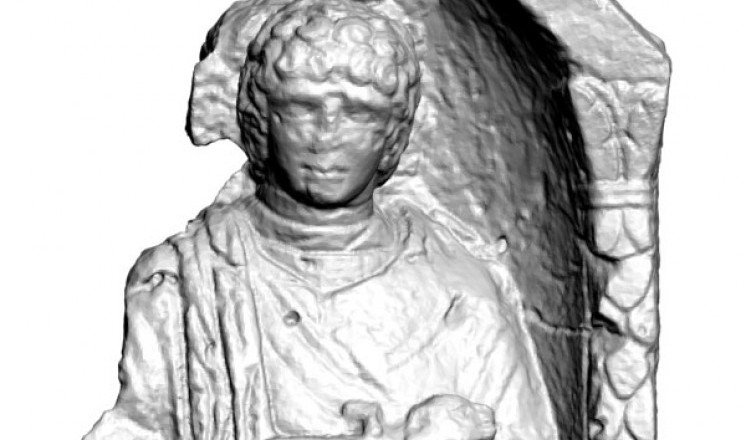Laura Ince on the Lincoln 3D Scans project with Oliver Laric
RSS FeedSo far on the 3D scanning Project, running from October 2013 through to early next year 2014. I am The Collection’s scanner intern for this project and I will be responsible for this blog and producing numerous scans which can be seen on the website [url=http://www.lincoln3dscans.co.uk]http://www.lincoln3dscans.co.uk[/url]
Hello! my name is Laura Nicole Ince, I am a fine art graduate from the University of Lincoln, graduated in September 2013. I have been given this opportunity and role to become a 3D Scanner intern working with The Collection and closely working with the artist Oliver Laric.
About the project
Within the first few days of starting my new job on the 2 October 2013 I had learnt a vast amount about the technology and the magnificence of the scanner's capability when scanning objects and artefacts. The 3D scanner we are using for this project is a portable scanner, therefore perfect for manoeuvring around the artefacts and sculptures at The Collection, The Usher Gallery and The Museum of Lincolnshire Life. The scanner relies on a power source but an extension cable is always to hand when we begin a scan. The software and technology we use to create these scans are custom made and designed for this specific project and the task we have set out to achieve. VXelements 2.0 is the program used on our laptop with an extremely large core processor as the scanning uses a mass amount of memory. VXelements is designed to work with 3D scanners and aims to capture this high resolution data and processes this into a workable STL File, which will be available for access on this website. The image produced is an accurate, dynamic image which can then be utilised and worked with as needs be.
October 2013 has been a very busy month with getting to grips with scanner and the technology. Maggie Warren and Ashley Gallant have trained me and discussed the instructions to follow when scanning artefacts and the settings which need to be matched to these specific requirements of the objects size and texture. When first handling the scanner you come to terms with the how extraordinary and clever the scanner is, as it remembers where and what you have scanned. This, I found, was remarkable. Completing several scans early October, we have come to the conclusion the scanner takes well to our collection of ‘Busts’. This is something we’ve taken advantage too.
Thursday 10 October, Maggie and I scanned the Kayak in the Paul Johnson exhibition at The Usher Gallery. The Kayak was selected from The Collection's stored collections along with a handful of other artefacts in the show named Theres something about you that I’m unsure about.
Scanning this Kayak had become a difficult task to complete due to shape, position and the material of the Kayak, completing this scan became a real battle on how best to finish the 3D image. The method was testing our patience and we had to maintain a very slow and steady pace to gain just over half of the scan completed. This I would like to say personally was our most ambitious scan yet to achieve. However it has taught us even more about the scanner and it was not a lesson wasted. During this month Maggie and I visited The Museum of Lincolnshire Life one day to scan the agricultural artefacts and objects in storage in the outer building. Maggie and I discussed ideas on which artefacts we’re both interested to scan not only for a purpose but also to experiment with larger and smaller objects. Some artefacts in particular that we found especially difficult to scan were the horse shoe, blacksmith's hand implement, and the rake. This could possibly be down to numerous factors, but as I am still getting used to the scanner, these are all lessons about the process.
From scanning various intricate objects I have learnt that decorative artefacts are a difficult issue for the scanner. As light cannot reach into the relief pattern, patience is the key, as you try to direct the scanner into the crevices of the object to achieve a whole success.
From October’s gradual success through to a very successful month of scanning, November 2013 Maggie and I have visited the Lincolnshire Archives archaeological storage multiple times scanning stone work. I have also had the privilege to scan a great and important roman relic, in regards to the city of Lincoln. This plaster column made from local sources of Limestone found in 1906 in the location of Monks Road, Lincoln. The Female figure on the column, which has said to be holding a cornucopia a horn symbolising abundance and nourishment an often filled with flowers, food and wealth in some form. This figure in roman times is said to be the representation of in Lincoln in other words, this woman is the roman guardian spirit of Lincoln. This woman was a Tyche, which is a guardian that governed the fortune and prosperity of a city.
Wednesday 20 November was an exciting an unusual day for me as I was working till late in the evening when the museum was closed working on several artefacts in the roman display towards the back of the room. Here is the list of items and descriptions of the work that you can find yourself on the Roman display at the museum.
All of the scans we have started have been completed, however there are still many more to be uploaded to the website as STL files. So please keep looking as we will be updating the website with more scans.
By Laura Ince
3D Scanning Intern
Comments
There aren’t any comments for this blog yet

